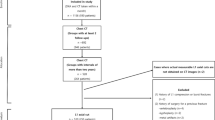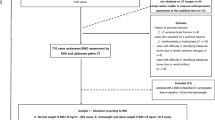Abstract
Objectives
To develop age-, gender-, and regional-specific normative values for texture analysis (TA) of spinal computed tomography (CT) in subjects with normal bone mineral density (BMD), as defined by dual X-ray absorptiometry (DXA), and to determine age-, gender-, and regional-specific differences.
Materials and methods
In this retrospective, IRB-approved study, TA was performed on sagittal CT bone images of the thoracic and lumbar spine using dedicated software (MaZda) in 141 individuals with normal DXA BMD findings. Numbers of female and male subjects were balanced in each of six age decades. Three hundred and five TA features were analyzed in thoracic and lumbar vertebrae using free-hand regions-of-interest. Intraclass correlation (ICC) coefficients were calculated for determining intra- and inter-observer agreement of each feature. Further dimension reduction was performed with correlation analyses.
Results
The TA features with an ICC < 0.81 indicating compromised intra- and inter-observer agreement and with Pearson correlation scores r > 0.8 with other features were excluded from further analysis for dimension reduction. From the remaining 31 texture features, a significant correlation with age was found for the features mean (r = −0.489, p < 0.001), variance (r = −0.681, p < 0.001), kurtosis (r = 0.273, p < 0.001), and WavEnLL_s4 (r = 0.273, p < 0.001). Significant differences were found between genders for various higher-level texture features (p < 0.001). Regional differences among the thoracic spine, thoracic–lumbar junction, and lumbar spine were found for most TA features (p < 0.021).
Conclusion
This study established normative values of TA features on CT images of the spine and showed age-, gender-, and regional-specific differences in individuals with normal BMD as defined by DXA.



Similar content being viewed by others
Abbreviations
- BMI:
-
Body mass index
- CT:
-
Computed tomography
- DICOM:
-
Digital imaging and communications in medicine
- DXA:
-
Dual X-ray absorptiometry
- FOV:
-
Field of view
- GLCM:
-
Gray level co-occurrence matrix
- IRB:
-
Institutional review board
- kVp:
-
Peak kilovoltage
- L:
-
Lumbar vertebra(e)
- RLM:
-
Run length matrix
- SD:
-
Standard deviation
- TA:
-
Texture analysis
- Th:
-
Thoracic vertebra(e)
- TLJ:
-
Thoracic–lumbar junction
References
Aerts HJ, Velazquez ER, Leijenaar RT, Parmar C, Grossmann P, Carvalho S, et al. Decoding tumour phenotype by noninvasive imaging using a quantitative radiomics approach. Nat Commun. 2014;5:4006.
Tourassi GD. Journey toward computer-aided diagnosis: role of image texture analysis. Radiology. 1999;213(2):317–20.
Kassner A, Liu F, Thornhill RE, Tomlinson G, Mikulis DJ. Prediction of hemorrhagic transformation in acute ischemic stroke using texture analysis of postcontrast T1-weighted MR images. J Magn Reson Imaging. 2009;30(5):933–41.
Skogen K, Schulz A, Dormagen JB, Ganeshan B, Helseth E, Server A. Diagnostic performance of texture analysis on MRI in grading cerebral gliomas. Eur J Radiol. 2016;85(4):824–9.
Yu V, Ruan D, Nguyen D, Kaprealian T, Chin R, Sheng K. SU-F-R-17: advancing glioblastoma multiforme (GBM) recurrence detection with MRI image texture feature extraction and machine learning. Fifty-eighth Annual Meeting of the American Association of Physicists in Medicine. Med Phys. 2016:3376–7.
Ganeshan B, Miles KA, Young RC, Chatwin CR. Texture analysis in non-contrast enhanced CT: impact of malignancy on texture in apparently disease-free areas of the liver. Eur J Radiol. 2009;70(1):101–10.
Ganeshan B, Abaleke S, Young RC, Chatwin CR, Miles KA. Texture analysis of non-small cell lung cancer on unenhanced computed tomography: initial evidence for a relationship with tumour glucose metabolism and stage. Cancer Imaging. 2010;10:137–43.
Rachidi M, Marchadier A, Gadois C, Lespessailles E, Chappard C, Benhamou CL. Laws’ masks descriptors applied to bone texture analysis: an innovative and discriminant tool in osteoporosis. Skeletal Radiol. 2008;37(6):541–8.
MacKay JW, Murray PJ, Kasmai B, Johnson G, Donell ST, Toms AP. MRI texture analysis of subchondral bone at the tibial plateau. Eur Radiol. 2016;26(9):3034–45.
MacKay JW, Murray PJ, Kasmai B, Johnson G, Donell ST, Toms AP. Subchondral bone in osteoarthritis: association between MRI texture analysis and histomorphometry. Osteoarthritis Cartilage. 2017;25(5):700–7.
MacKay JW, Murray PJ, Low SB, Kasmai B, Johnson G, Donell ST, et al. Quantitative analysis of tibial subchondral bone: texture analysis outperforms conventional trabecular microarchitecture analysis. J Magn Reson Imaging. 2016;43(5):1159–70.
Schneider E, Lo GH, Sloane G, Fanella L, Hunter DJ, Eaton CB, et al. Magnetic resonance imaging evaluation of weight-bearing subchondral trabecular bone in the knee. Skeletal Radiol. 2011;40(1):95–103.
Phan CM, Macklin EA, Bredella MA, Dadrich M, Flechsig P, Yoo AJ, et al. Trabecular structure analysis using C-arm CT: comparison with MDCT and flat-panel volume CT. Skeletal Radiol. 2011;40(8):1065–72.
Frighetto-Pereira L, Rangayyan RM, Metzner GA, de Azevedo-Marques PM, Nogueira-Barbosa MH. Shape, texture and statistical features for classification of benign and malignant vertebral compression fractures in magnetic resonance images. Comput Biol Med. 2016;73:147–56.
Link TM. Osteoporosis imaging: state of the art and advanced imaging. Radiology. 2012;263(1):3–17.
Tabari A, Torriani M, Miller KK, Klibanski A, Kalra MK, Bredella MA. Anorexia nervosa: analysis of trabecular texture with CT. Radiology. 2017;283(1):178–85
Cosman F, Crittenden DB, Adachi JD, Binkley N, Czerwinski E, Ferrari S, et al. Romosozumab treatment in postmenopausal women with osteoporosis. N Engl J Med. 2016;375(16):1532–43.
Szczypinski PM, Strzelecki M, Materka A, Klepaczko A. MaZda—a software package for image texture analysis. Comput Methods Prog Biomed. 2009;94(1):66–76.
Collewet G, Strzelecki M, Mariette F. Influence of MRI acquisition protocols and image intensity normalization methods on texture classification. Magn Reson Imaging. 2004;22(1):81–91.
Griffith JF, Yeung DK, Ma HT, Leung JC, Kwok TC, Leung PC. Bone marrow fat content in the elderly: a reversal of sex difference seen in younger subjects. J Magn Reson Imaging. 2012;36(1):225–30.
Mahato NK. Trabecular bone structure in lumbosacral transitional vertebrae: distribution and densities across sagittal vertebral body segments. Spine J. 2013;13(8):932–7.
Landis JR, Koch GG. The measurement of observer agreement for categorical data. Biometrics. 1977;33(1):159–74.
Raman SP, Chen Y, Schroeder JL, Huang P, Fishman EK. CT texture analysis of renal masses: pilot study using random forest classification for prediction of pathology. Acad Radiol. 2014;21(12):1587–96.
Potdevin G, Malecki A, Biernath T, Bech M, Jensen TH, Feidenhans’l R, et al. X-ray vector radiography for bone micro-architecture diagnostics. Phys Med Biol. 2012;57(11):3451–61.
Leboeuf-Yde C, Nielsen J, Kyvik KO, Fejer R, Hartvigsen J. Pain in the lumbar, thoracic or cervical regions: do age and gender matter? A population-based study of 34,902 Danish twins 20-71 years of age. BMC Musculoskelet Disord. 2009;10:39.
Yeni YN, Zinno MJ, Yerramshetty JS, Zauel R, Fyhrie DP. Variability of trabecular microstructure is age-, gender-, race- and anatomic site-dependent and affects stiffness and stress distribution properties of human vertebral cancellous bone. Bone. 2011;49(4):886–94.
Terashima Y, Yurube T, Hirata H, Sugiyama D, Sumi M, Hyogo Organization of Spinal Disorders. Predictive risk factors of cervical spine instabilities in rheumatoid arthritis: a prospective multicenter over 10-year cohort study. Spine. 2017; 42(8):556–64.
Author information
Authors and Affiliations
Corresponding author
Ethics declarations
Conflicts of interest
The authors declare that they have no conflicts of interest.
Rights and permissions
About this article
Cite this article
Mannil, M., Eberhard, M., Becker, A.S. et al. Normative values for CT-based texture analysis of vertebral bodies in dual X-ray absorptiometry-confirmed, normally mineralized subjects. Skeletal Radiol 46, 1541–1551 (2017). https://doi.org/10.1007/s00256-017-2728-0
Received:
Revised:
Accepted:
Published:
Issue Date:
DOI: https://doi.org/10.1007/s00256-017-2728-0




